Full text
PDF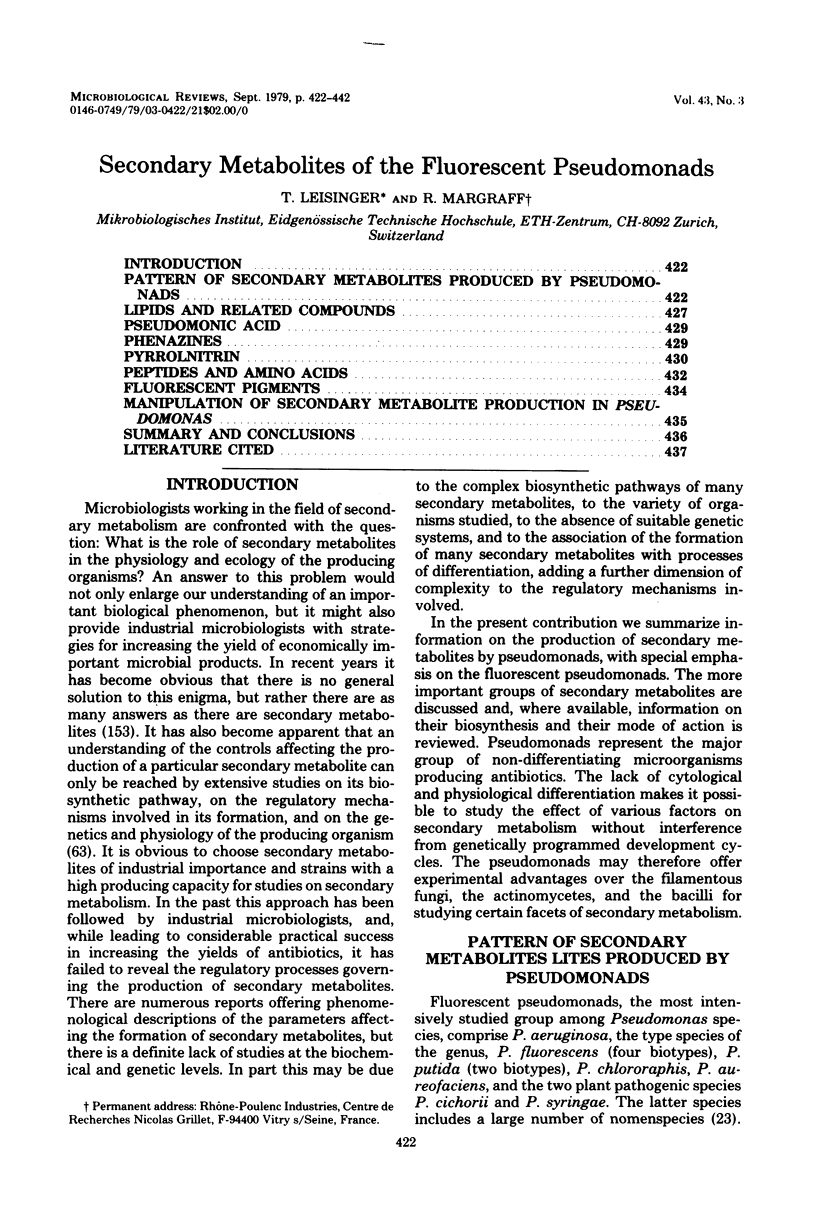
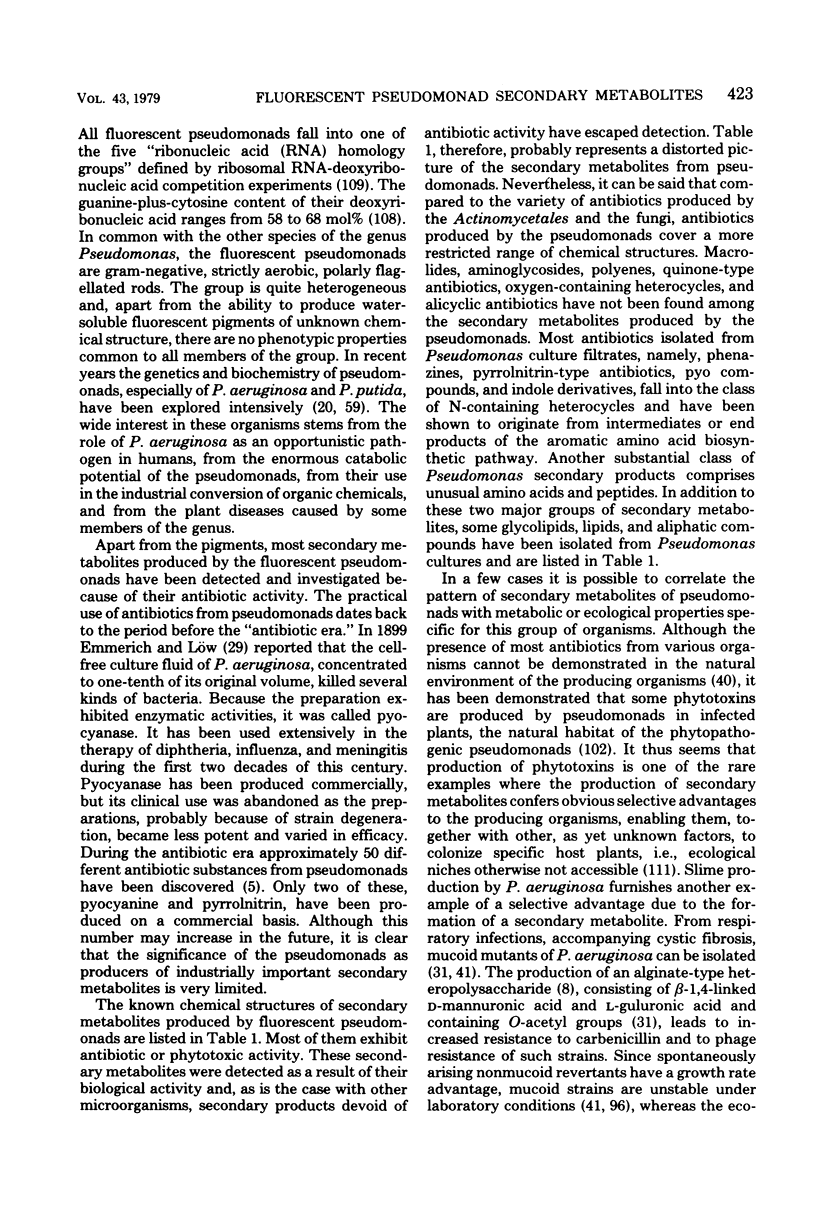
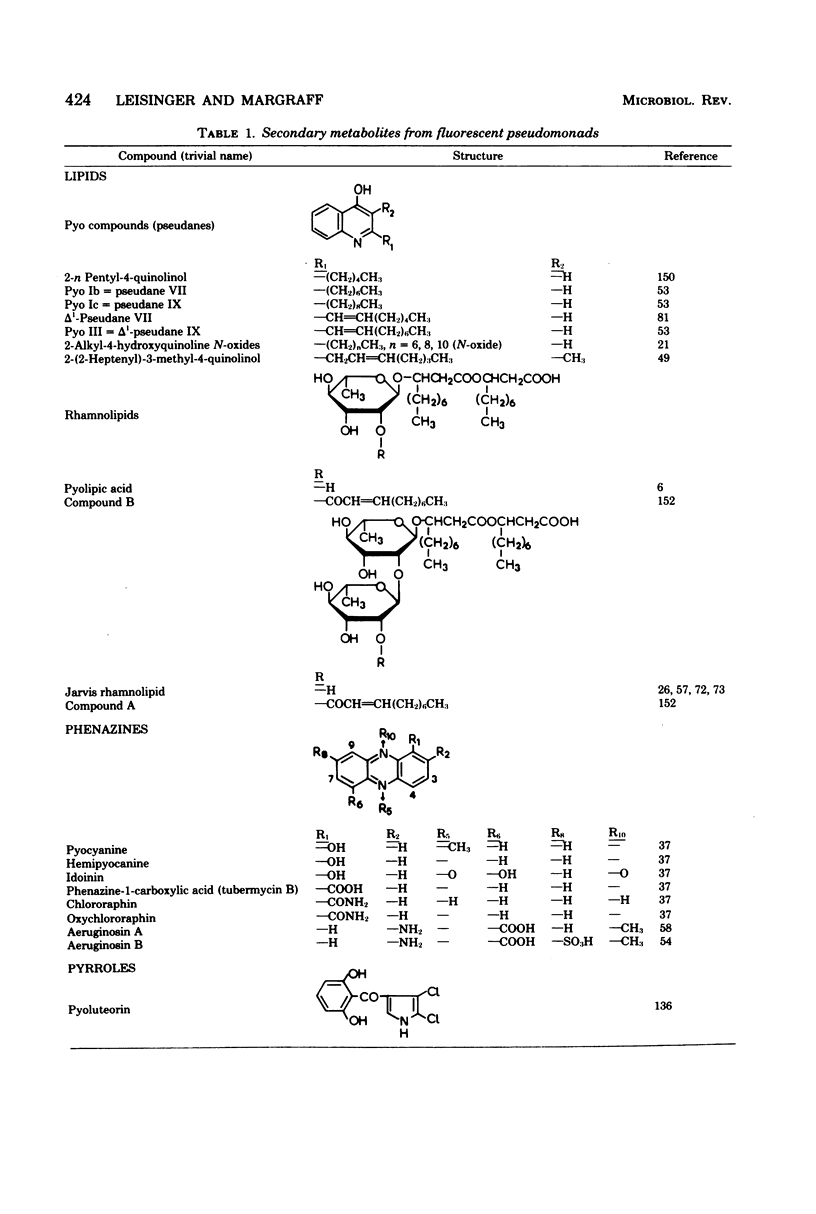
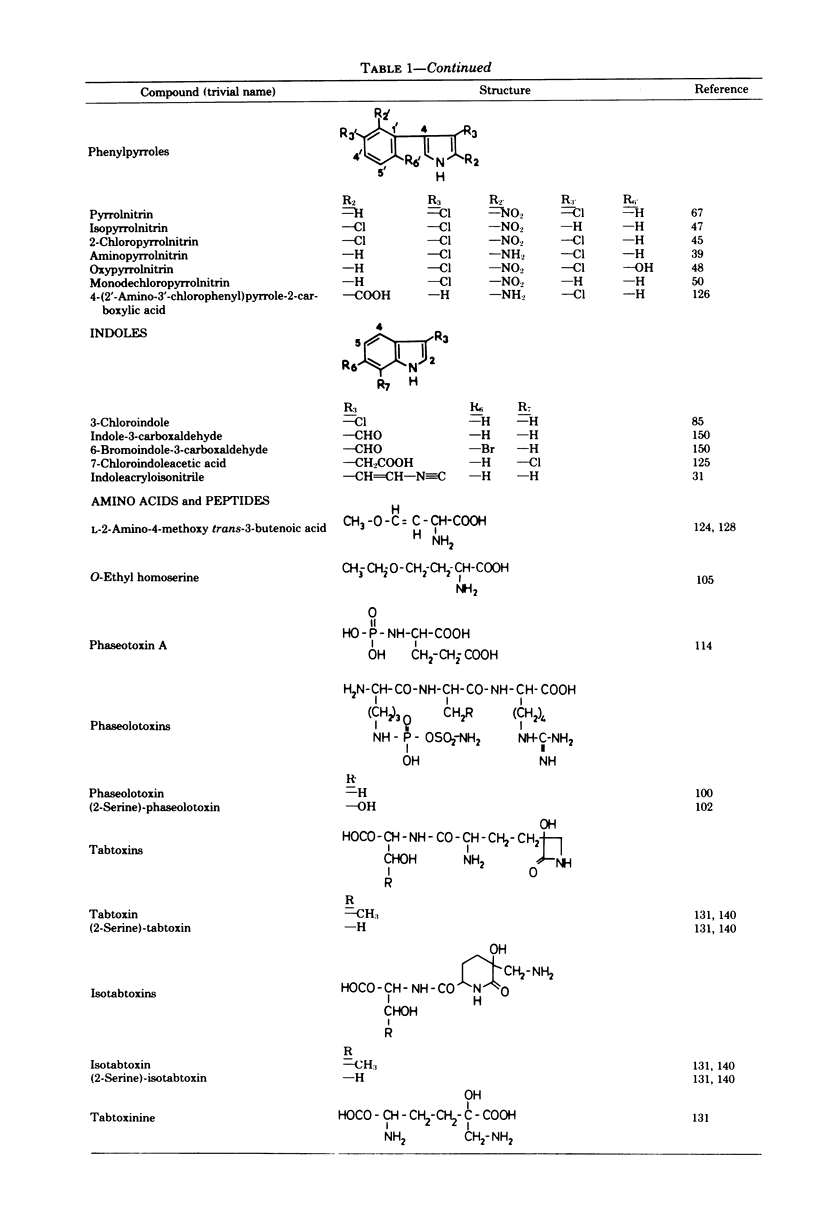
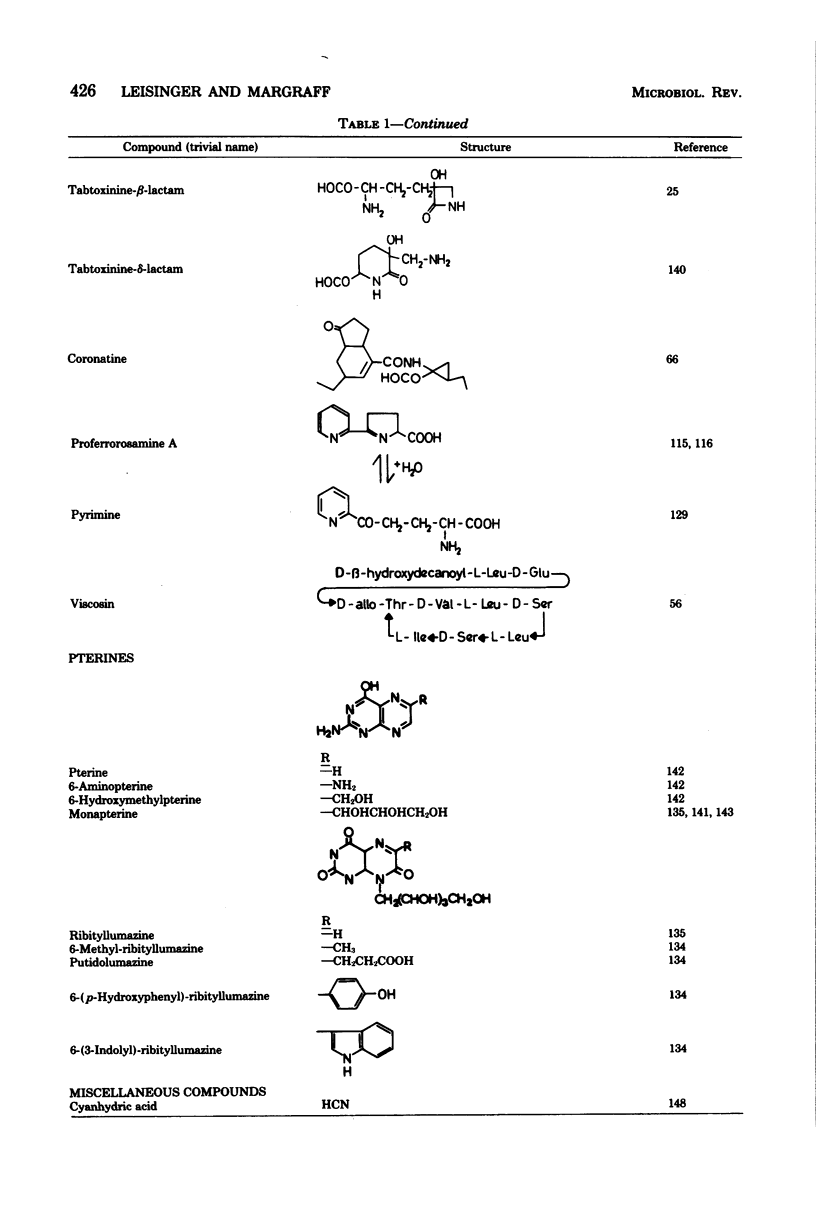
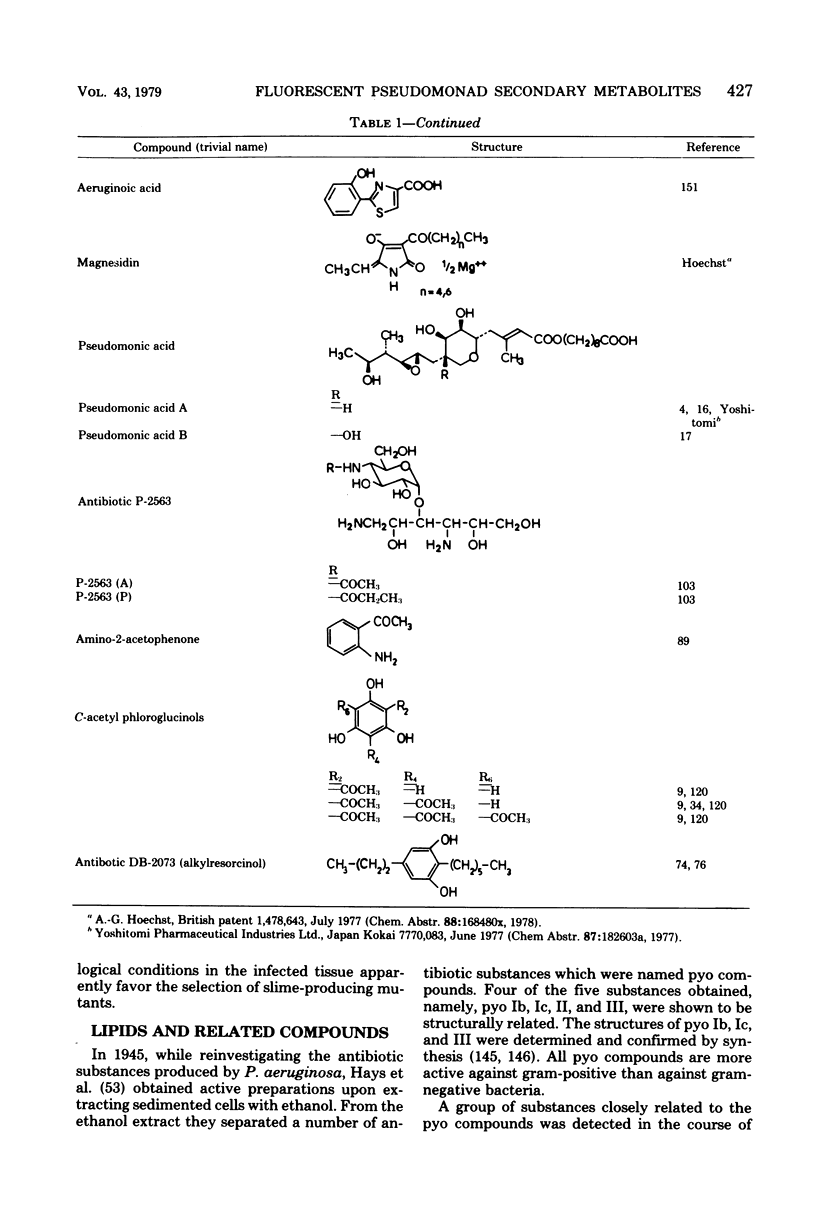
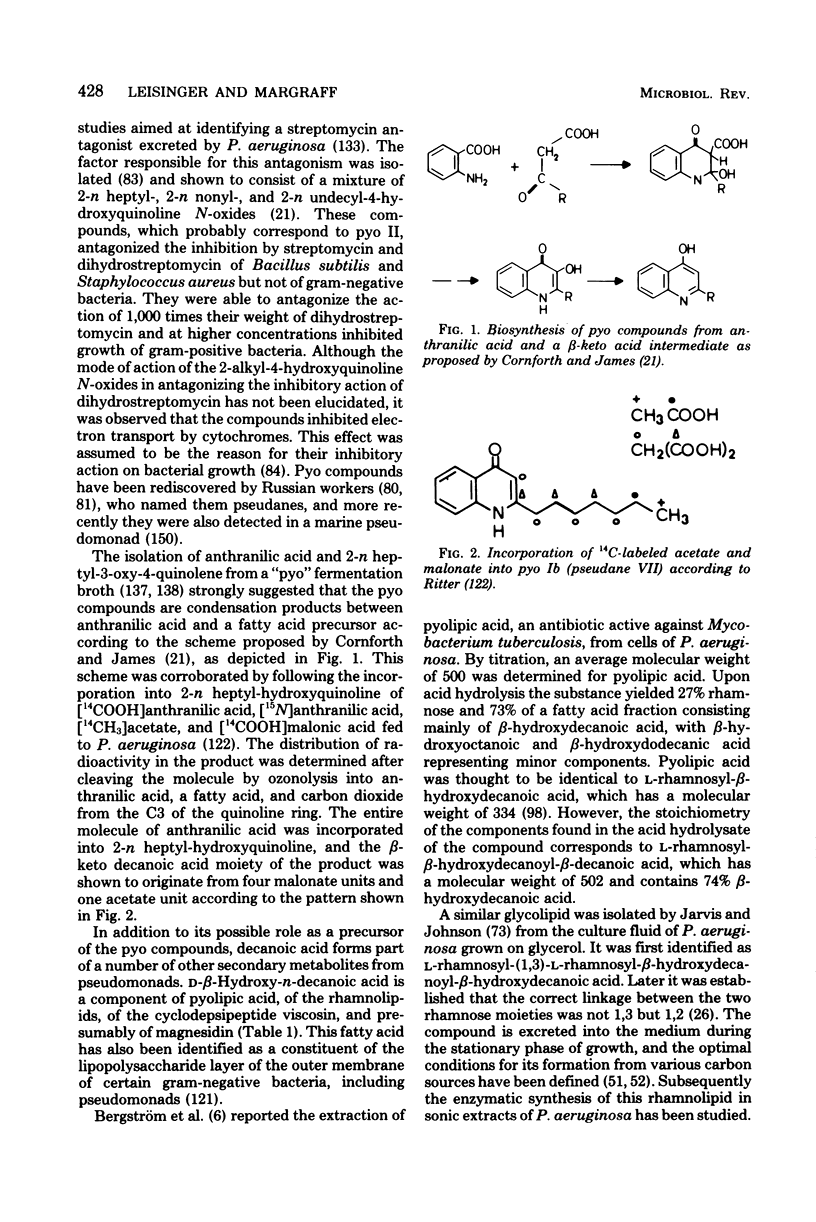
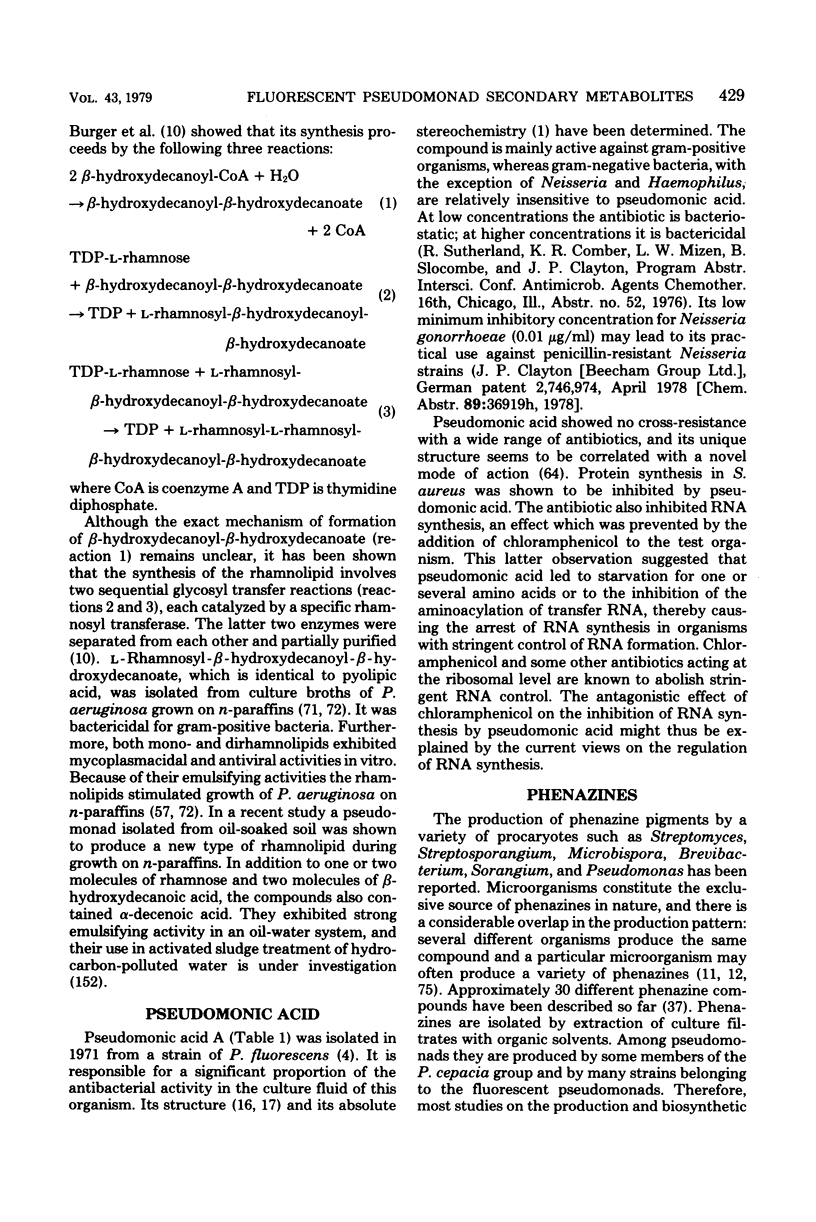
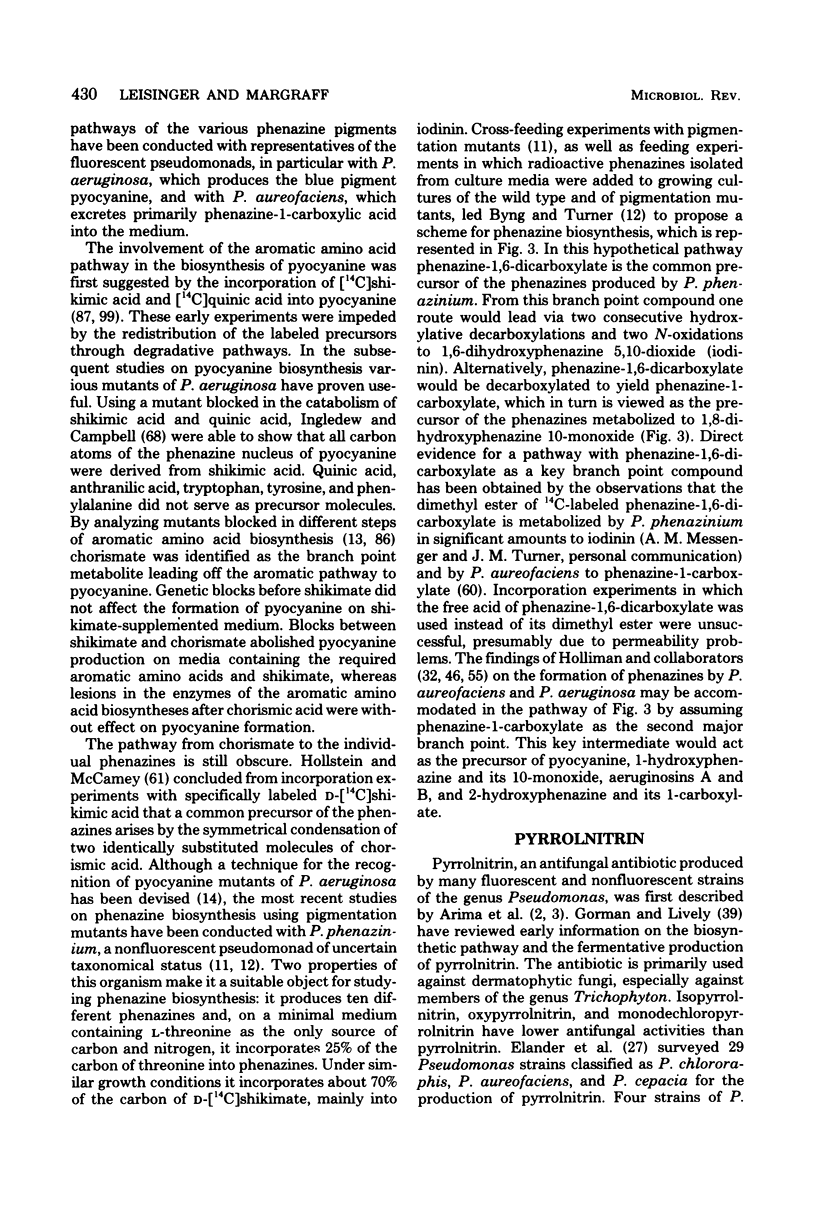
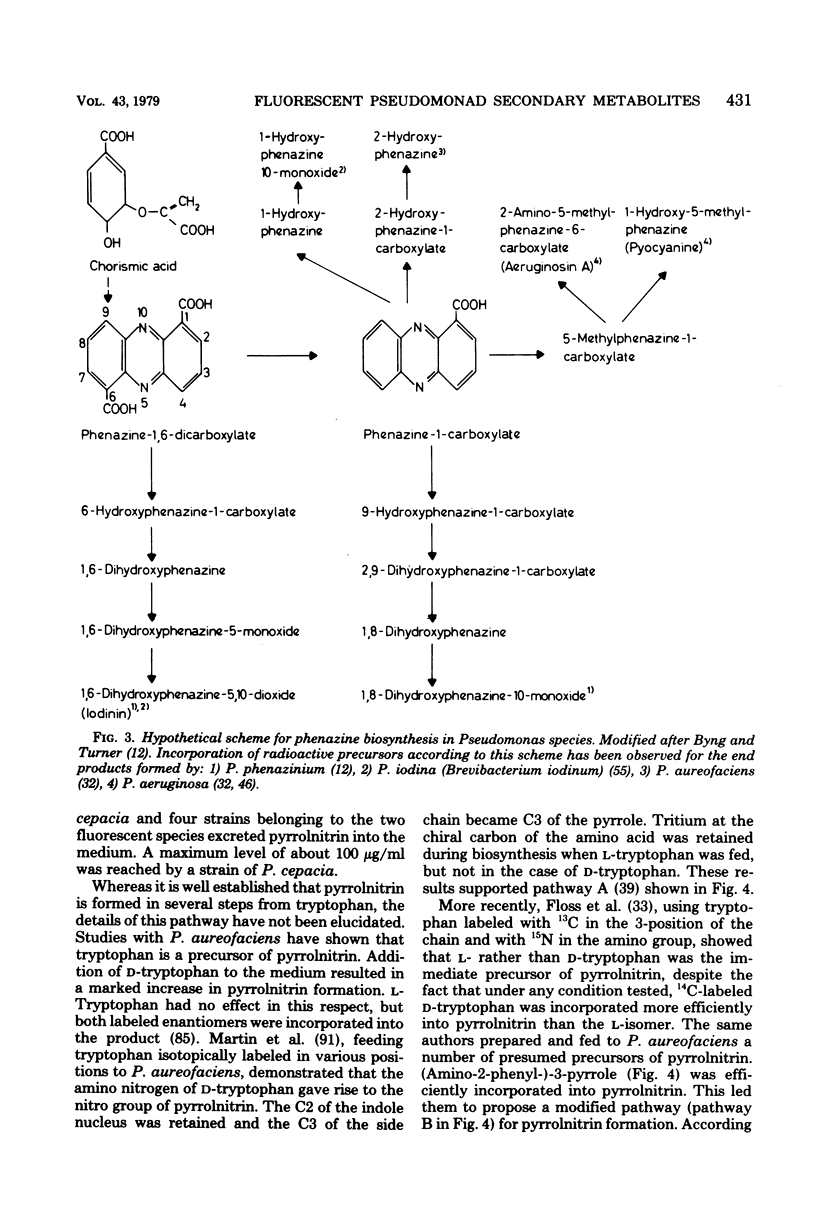
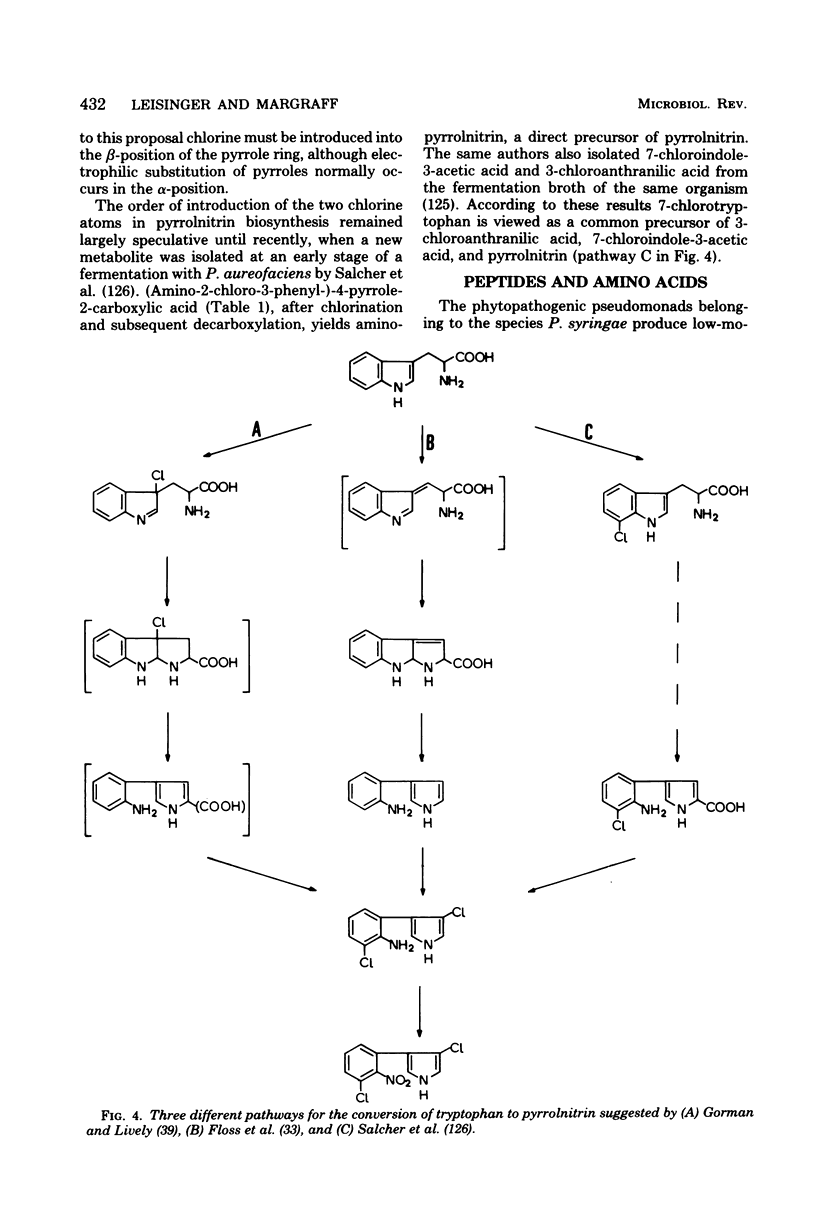
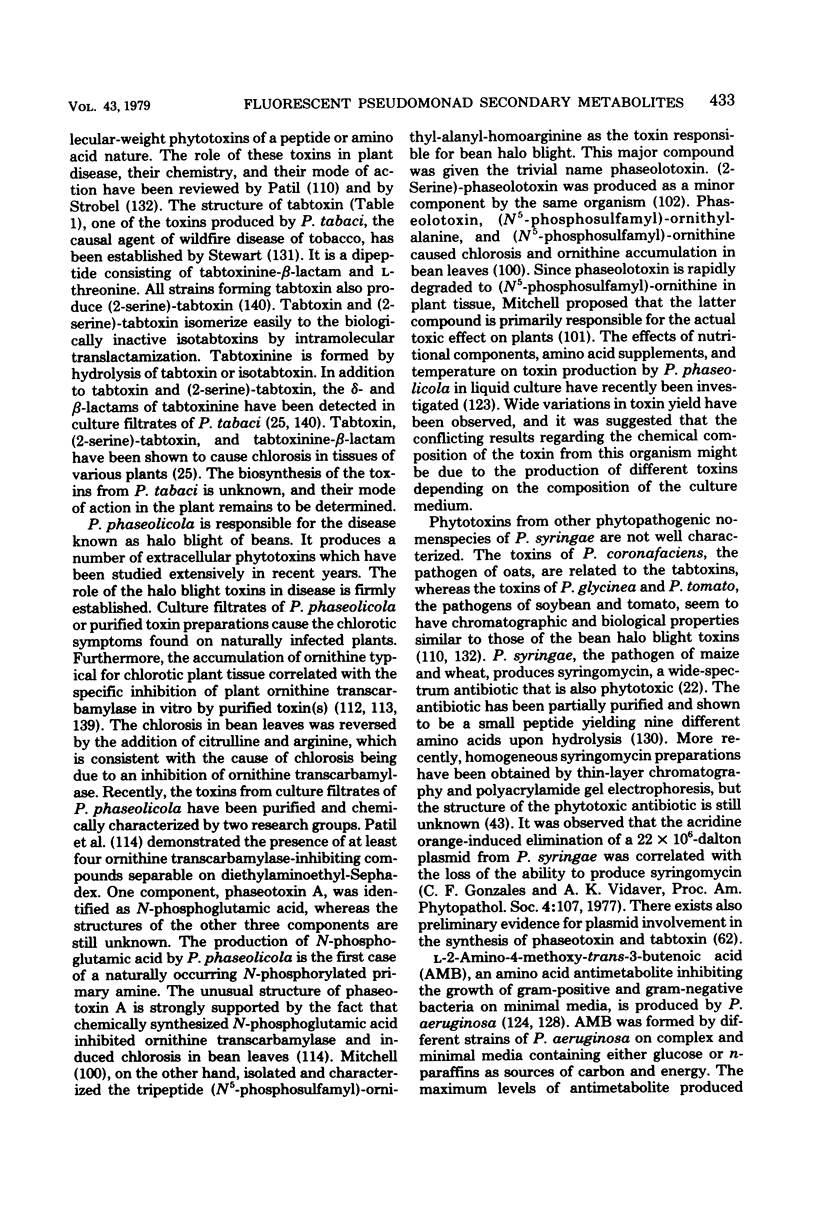
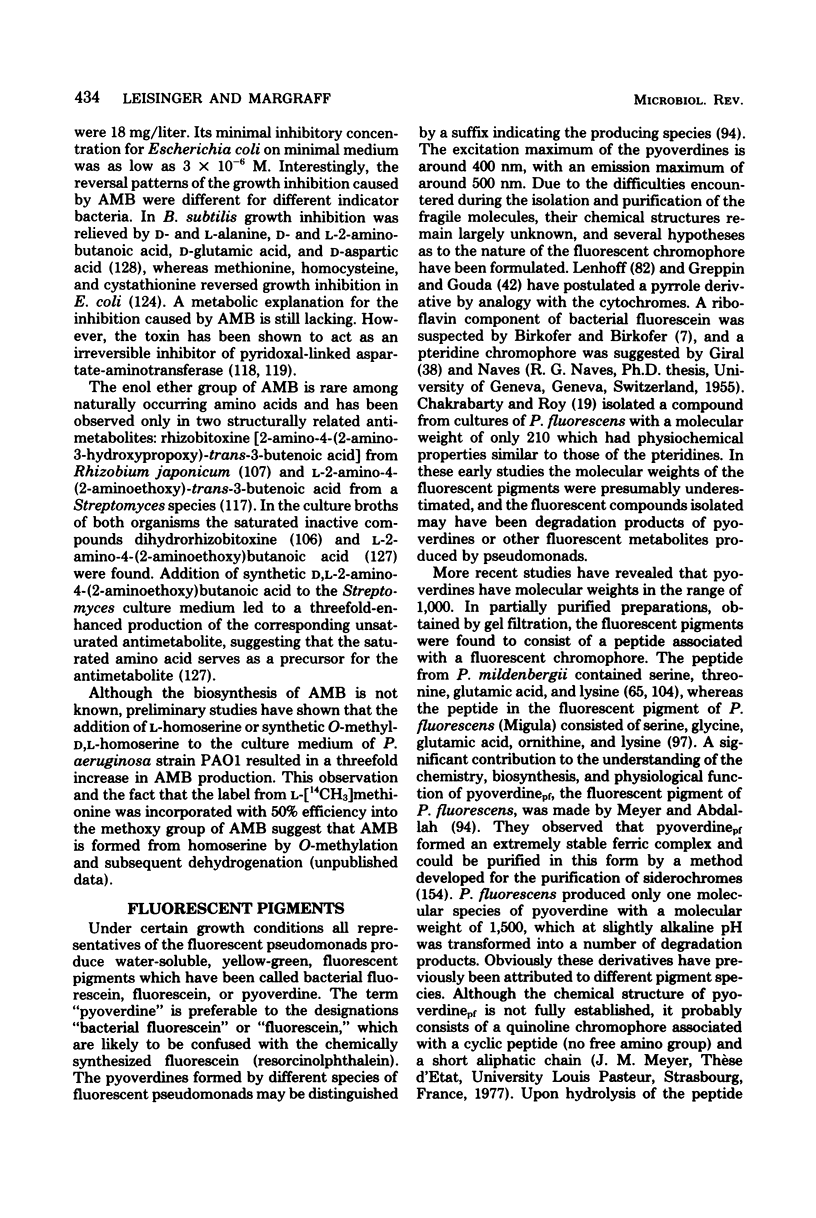
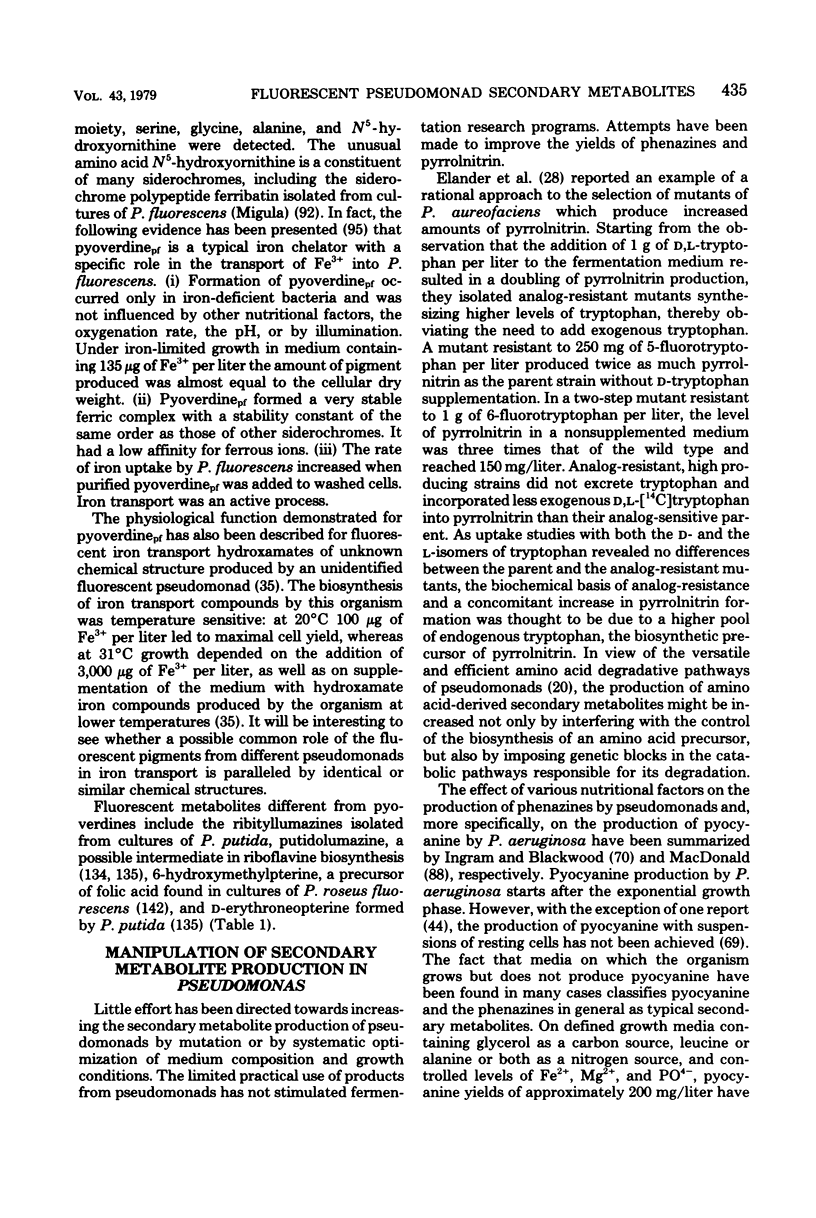
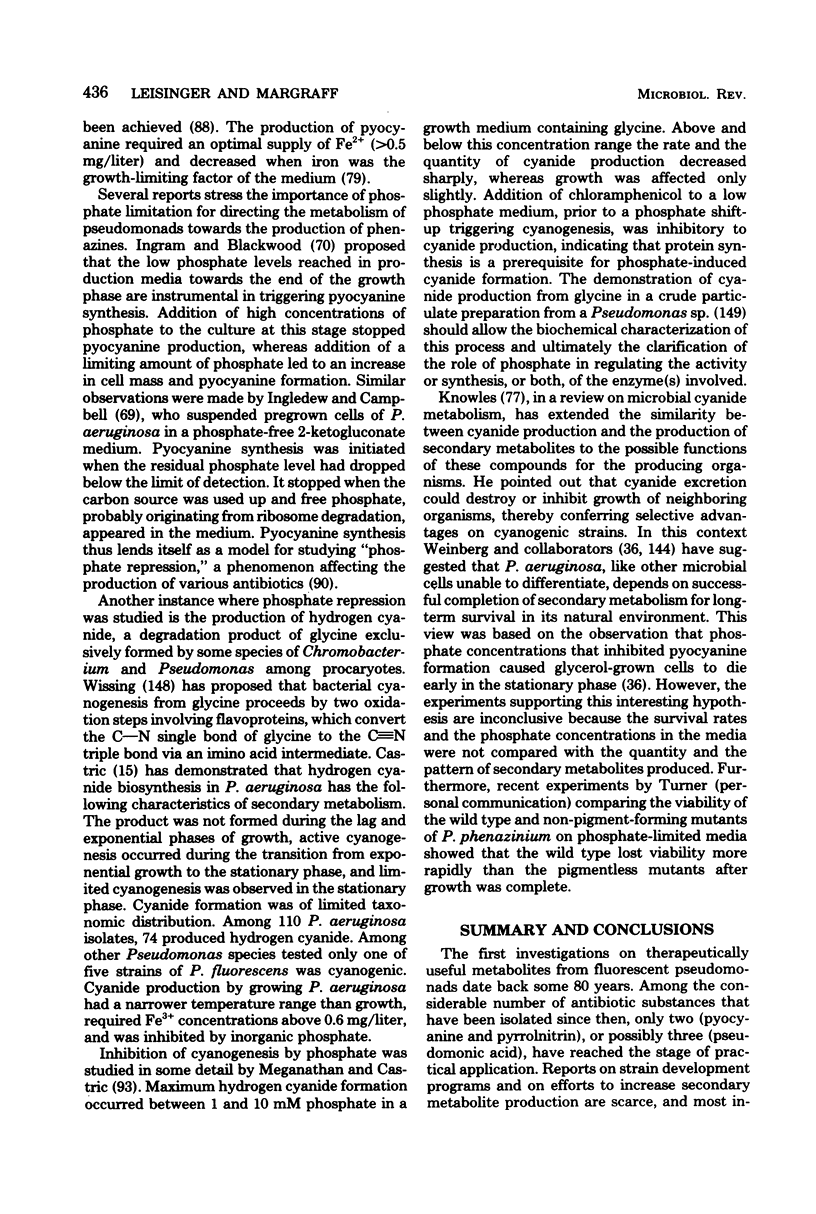
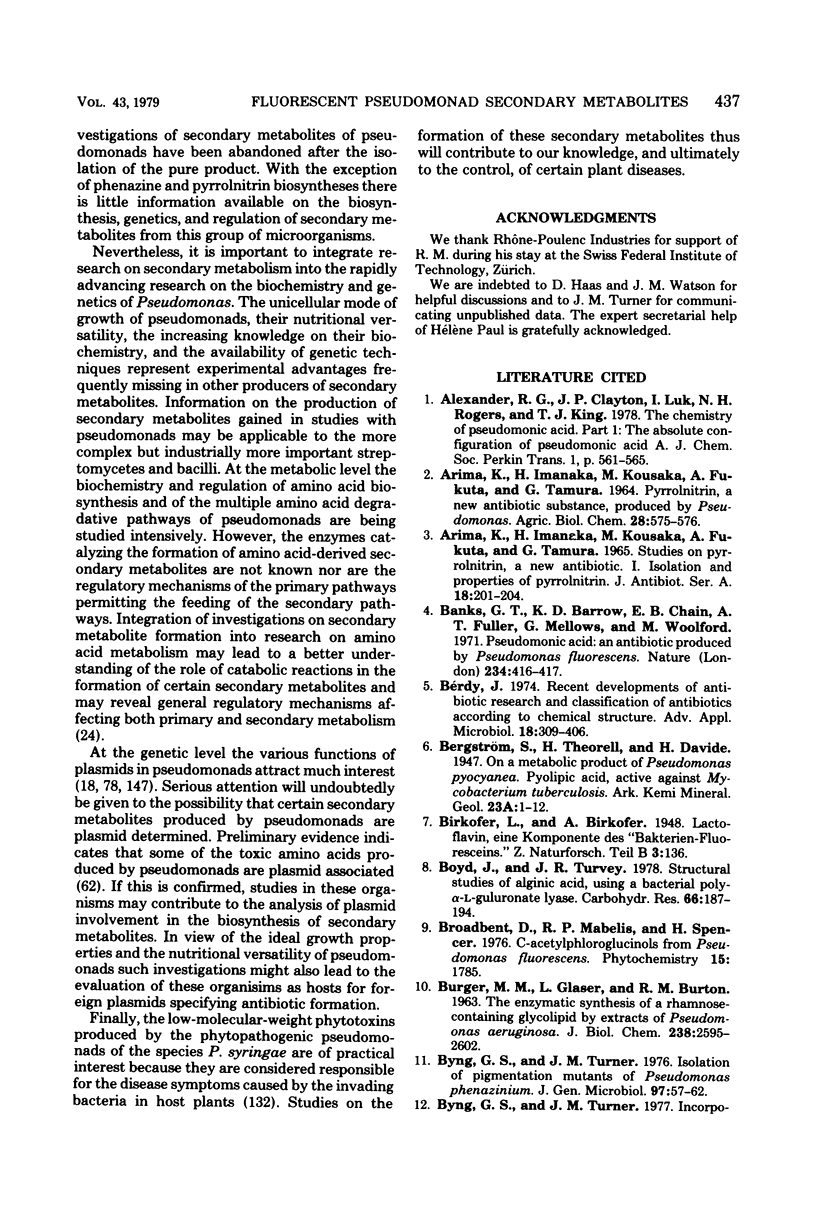
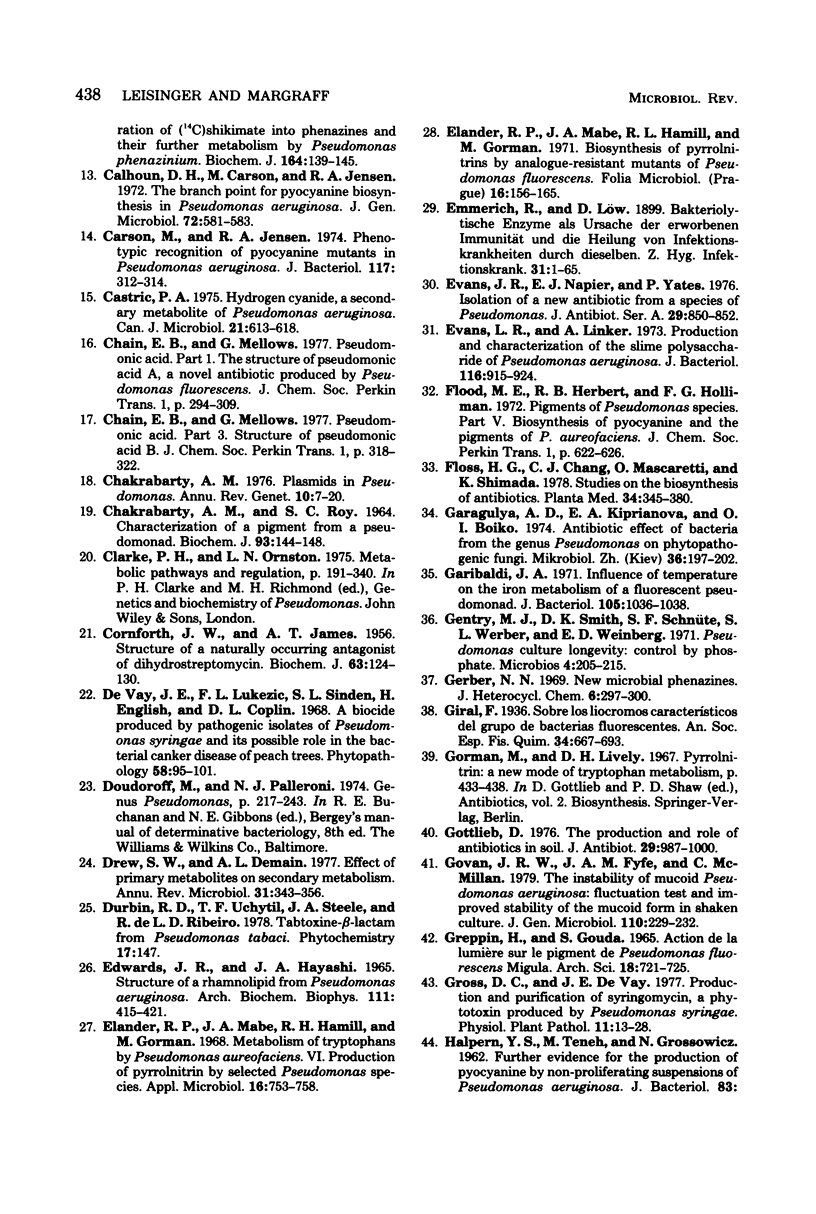
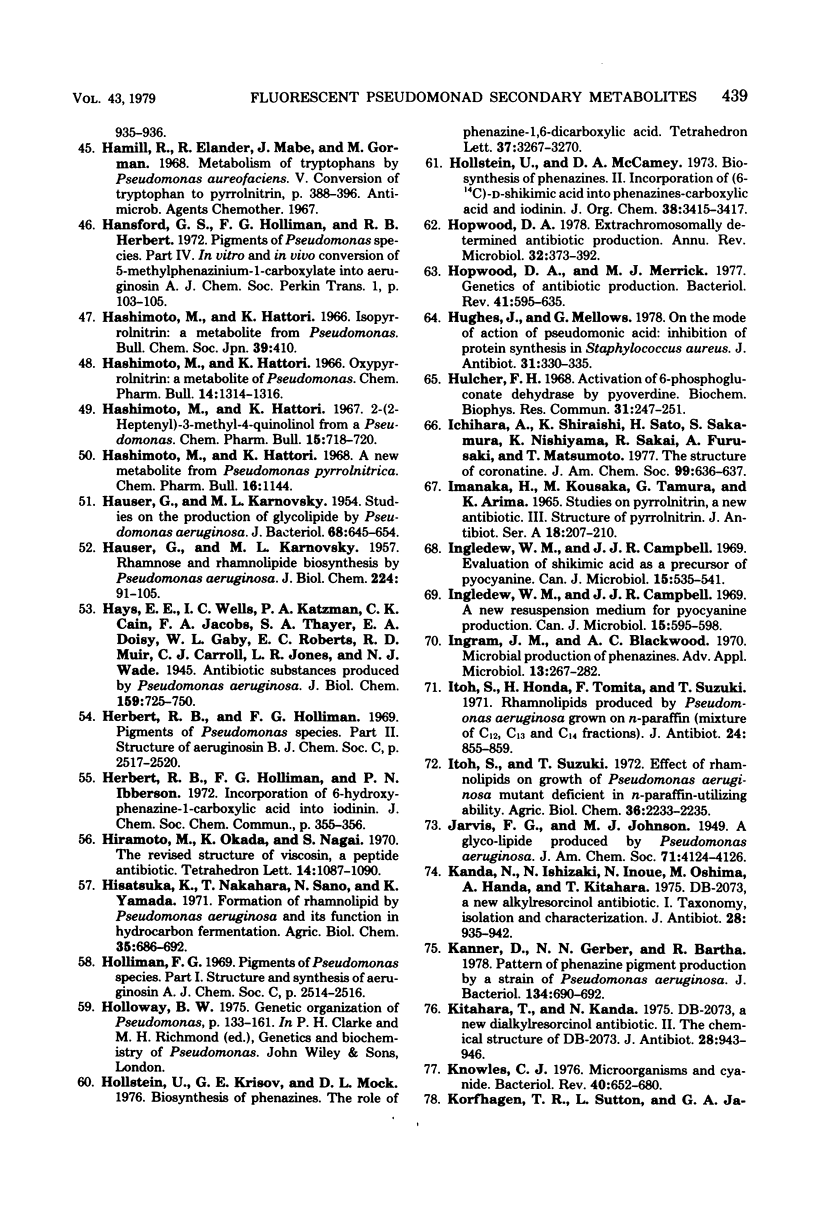
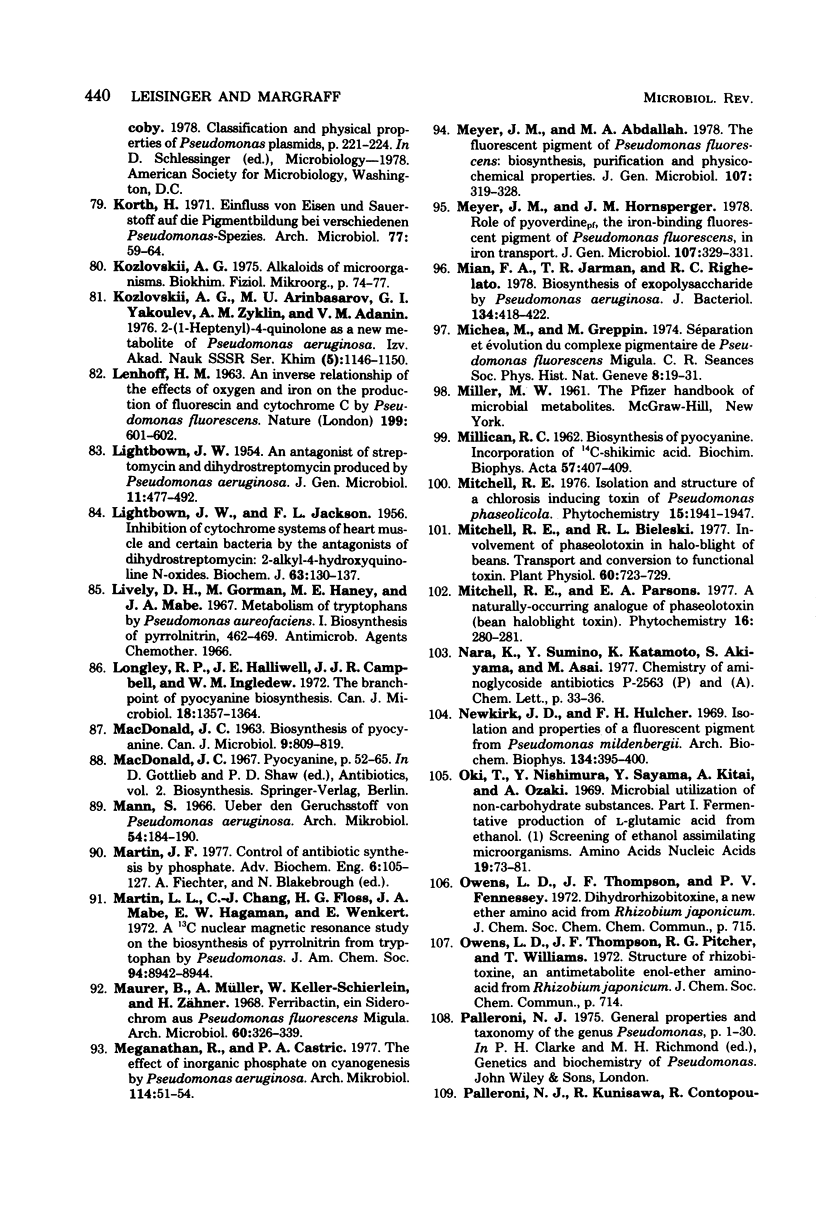
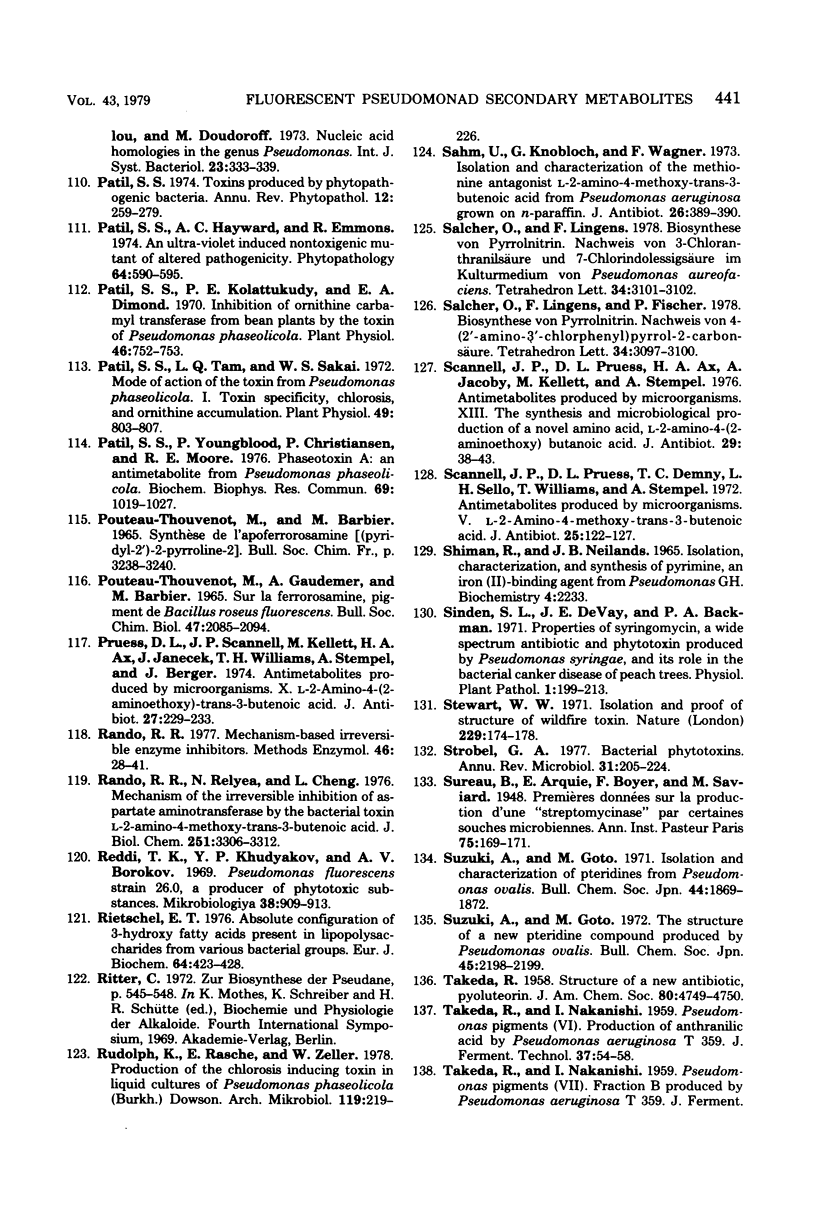
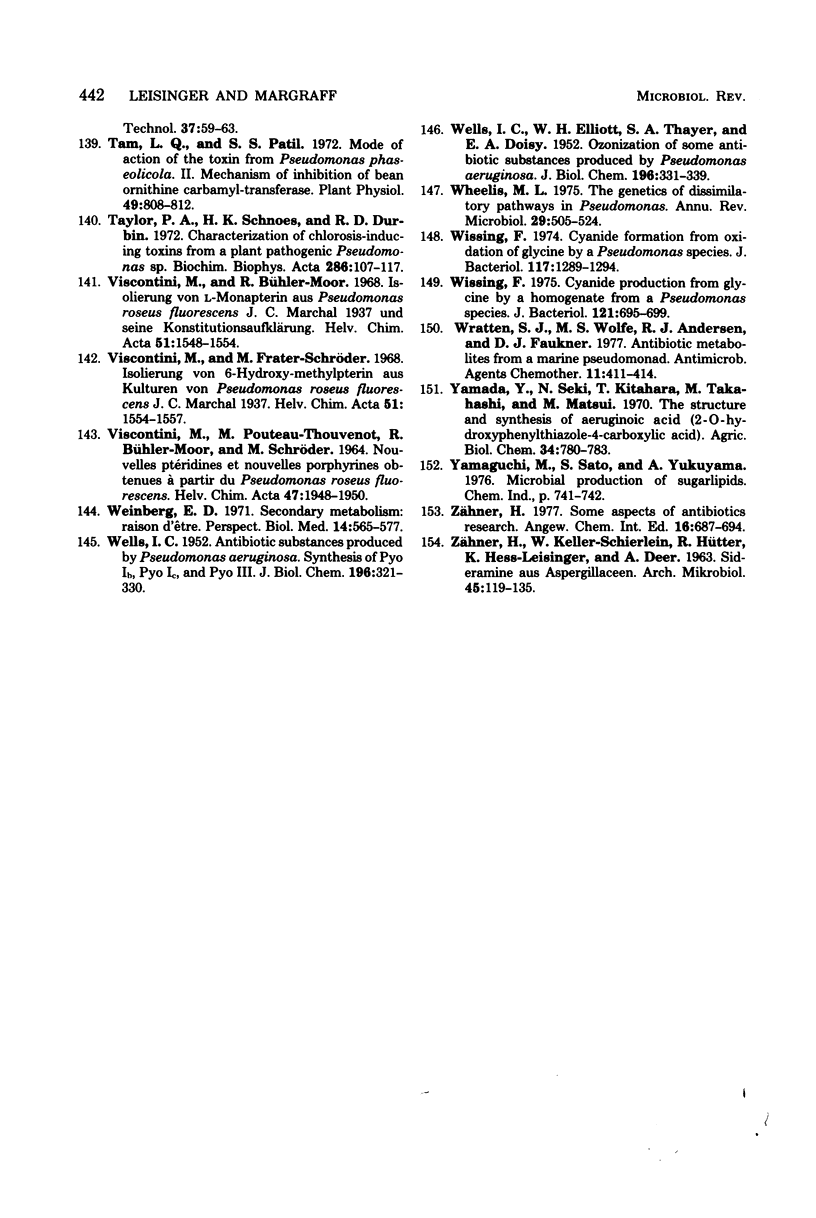
Selected References
These references are in PubMed. This may not be the complete list of references from this article.
- A 13C nuclear magnetic resonance study on the biosynthesis of pyrrolnitrin from tryptophan by Pseudomonas. J Am Chem Soc. 1972 Dec 13;94(25):8942–8944. doi: 10.1021/ja00780a070. [DOI] [PubMed] [Google Scholar]
- Arima K., Imanaka H., Kousaka M., Fukuda A., Tamura G. Studies on pyrrolnitrin, a new antibiotic. I. Isolation and properties of pyrrolnitrin. J Antibiot (Tokyo) 1965 Sep;18(5):201–204. [PubMed] [Google Scholar]
- BURGER M. M., GLASER L., BURTON R. M. THE ENZYMATIC SYNTHESIS OF A RHAMNOSE-CONTAINING GLYCOLIPID BY EXTRACTS OF PSEUDOMONAS AERUGINOSA. J Biol Chem. 1963 Aug;238:2595–2602. [PubMed] [Google Scholar]
- Byng G. S., Turner J. M. Incorporation of [14C]shikimate into plenazines and their further metabolism by Pseudomonas phenazinium. Biochem J. 1977 Apr 15;164(1):139–145. doi: 10.1042/bj1640139. [DOI] [PMC free article] [PubMed] [Google Scholar]
- Byng G. S., Turner J. M. Isolation of pigmentation mutants of Pseudomonas phenazinium. J Gen Microbiol. 1976 Nov;97(1):57–62. doi: 10.1099/00221287-97-1-57. [DOI] [PubMed] [Google Scholar]
- Bérdy J. Recent developments of antibiotic research and classification of antibiotics according to chemical structure. Adv Appl Microbiol. 1974;18(0):309–406. [PubMed] [Google Scholar]
- CORNFORTH J. W., JAMES A. T. Structure of a naturally occurring antagonist of dihydrostreptomycin. Biochem J. 1956 May;63(1):124–130. doi: 10.1042/bj0630124. [DOI] [PMC free article] [PubMed] [Google Scholar]
- Calhoun D. H., Carson M., Jensen R. A. The branch point metabolite for pyocyanine biosynthesis in Pseudomonas aeruginosa. J Gen Microbiol. 1972 Oct;72(3):581–583. doi: 10.1099/00221287-72-3-581. [DOI] [PubMed] [Google Scholar]
- Carson M., Jensen R. A. Phenotype recognition of pyocyanine mutants in pseudomonas aeruginosa. J Bacteriol. 1974 Jan;117(1):312–314. doi: 10.1128/jb.117.1.312-314.1974. [DOI] [PMC free article] [PubMed] [Google Scholar]
- Castric P. A. Hydrogen cyanide, a secondary metabolite of Pseudomonas aeruginosa. Can J Microbiol. 1975 May;21(5):613–618. doi: 10.1139/m75-088. [DOI] [PubMed] [Google Scholar]
- Chain E. B., Mellows G. Pseudomonic acid. Part 1. The structure of pseudomonic acid A, a novel antibiotic produced by Pseudomonas fluorescens. J Chem Soc Perkin 1. 1977;(3):294–309. [PubMed] [Google Scholar]
- Chain E. B., Mellows G. Pseudomonic acid. Part 3. Structure of pseudomonic acid B. J Chem Soc Perkin 1. 1977;(3):318–324. [PubMed] [Google Scholar]
- Chakrabarty A. M. Plasmids in Pseudomonas. Annu Rev Genet. 1976;10:7–30. doi: 10.1146/annurev.ge.10.120176.000255. [DOI] [PubMed] [Google Scholar]
- Chakrabarty A. M., Roy S. C. Characterization of a pigment from a pseudomonad. Biochem J. 1964 Oct;93(1):144–148. doi: 10.1042/bj0930144. [DOI] [PMC free article] [PubMed] [Google Scholar]
- Drew S. W., Demain A. L. Effect of primary metabolites on secondary metabolism. Annu Rev Microbiol. 1977;31:343–356. doi: 10.1146/annurev.mi.31.100177.002015. [DOI] [PubMed] [Google Scholar]
- Edwards J. R., Hayashi J. A. Structure of a rhamnolipid from Pseudomonas aeruginosa. Arch Biochem Biophys. 1965 Aug;111(2):415–421. doi: 10.1016/0003-9861(65)90204-3. [DOI] [PubMed] [Google Scholar]
- Elander R. P., Mabe J. A., Hamill R. H., Gorman M. Metabolism of tryptophans by Pseudomonas aureofaciens. VI. Production of pyrrolnitrin by selected Pseudomonas species. Appl Microbiol. 1968 May;16(5):753–758. doi: 10.1128/am.16.5.753-758.1968. [DOI] [PMC free article] [PubMed] [Google Scholar]
- Elander R. P., Mabe J. A., Hamill R. L., Gorman M. Biosynthesis of pyrrolnitrins by analogue-resistant mutants of Pseudomonas fluorescens. Folia Microbiol (Praha) 1971;16(3):156–165. doi: 10.1007/BF02884206. [DOI] [PubMed] [Google Scholar]
- Evans J. R., Napier E. J., Yates P. Isolation of a new antibiotic from a species of Pseudomonas. J Antibiot (Tokyo) 1976 Aug;29(8):850–852. doi: 10.7164/antibiotics.29.850. [DOI] [PubMed] [Google Scholar]
- Evans L. R., Linker A. Production and characterization of the slime polysaccharide of Pseudomonas aeruginosa. J Bacteriol. 1973 Nov;116(2):915–924. doi: 10.1128/jb.116.2.915-924.1973. [DOI] [PMC free article] [PubMed] [Google Scholar]
- Flood M. E., Herbert R. B., Holliman F. G. Pigments of Pseudomonas species. V. Biosynthesis of pyocyanin and the pigments of Ps. aureoaciens. J Chem Soc Perkin 1. 1972;4:622–626. doi: 10.1039/p19720000622. [DOI] [PubMed] [Google Scholar]
- Fuller A. T., Mellows G., Woolford M., Banks G. T., Barrow K. D., Chain E. B. Pseudomonic acid: an antibiotic produced by Pseudomonas fluorescens. Nature. 1971 Dec 17;234(5329):416–417. doi: 10.1038/234416a0. [DOI] [PubMed] [Google Scholar]
- Garagulia A. D., Kiprianova E. A., Boiko O. I. Antybiotychna diia bakterii rodu Pseudomonas na fitopatohenni hryby. Mikrobiol Zh. 1974 Feb-Mar;36(2):197–202. [PubMed] [Google Scholar]
- Garibaldi J. A. Influence of temperature on the iron metabolism of a fluorescent pseudomonad. J Bacteriol. 1971 Mar;105(3):1036–1038. doi: 10.1128/jb.105.3.1036-1038.1971. [DOI] [PMC free article] [PubMed] [Google Scholar]
- Gentry M. J., Smith D. K., Schnute S. F., Werber S. L., Weinberg E. D. Pseudomonas culture longevity: control by phosphate. Microbios. 1971 Dec;4(15):205–215. [PubMed] [Google Scholar]
- Gottlieb D. The production and role of antibiotics in soil. J Antibiot (Tokyo) 1976 Oct;29(10):987–1000. doi: 10.7164/antibiotics.29.987. [DOI] [PubMed] [Google Scholar]
- Govan J. R., Fyfe J. A., McMillan C. The instability of mucoid Pseudomonas aeruginosa: fluctuation test and improved stability of the mucoid form in shaken culture. J Gen Microbiol. 1979 Jan;110(1):229–232. doi: 10.1099/00221287-110-1-229. [DOI] [PubMed] [Google Scholar]
- HAUSER G., KARNOVSKY M. L. Rhamnose and rhamnolipide biosynthesis by Pseudomonas aeruginosa. J Biol Chem. 1957 Jan;224(1):91–105. [PubMed] [Google Scholar]
- HAUSER G., KARNOVSKY M. L. Studies on the production of glycolipide by Pseudomonas aeruginosa. J Bacteriol. 1954 Dec;68(6):645–654. doi: 10.1128/jb.68.6.645-654.1954. [DOI] [PMC free article] [PubMed] [Google Scholar]
- Hansford G. S., Holliman F. G., Herbert R. B. Pigments of Pseudomonas species. IV. In vitro and in vivo conversion of 5-methylphenazinium-1-carboxylate into aeruginosin A. J Chem Soc Perkin 1. 1972;1:103–105. doi: 10.1039/p19720000103. [DOI] [PubMed] [Google Scholar]
- Hashimoto M., Hattori K. 2-(2-heptenyl)-3-methyl-4-quinolinol from a Pseudomonas. Chem Pharm Bull (Tokyo) 1967 May;15(5):718–720. doi: 10.1248/cpb.15.718. [DOI] [PubMed] [Google Scholar]
- Hashimoto M., Hattori K. A new metabolite for Pseudomonas pyrrolnitirca. Chem Pharm Bull (Tokyo) 1968 Jun;16(6):1144–1144. [PubMed] [Google Scholar]
- Hashimoto M., Hattori K. Isopyrrolnitrin: a metabolite from Pseudomonas. Bull Chem Soc Jpn. 1966 Feb;39(2):410–410. doi: 10.1246/bcsj.39.410. [DOI] [PubMed] [Google Scholar]
- Hashimoto M., Hattori K. Oxypyrrolnitrin: a metabolite of Pseudomonas. Chem Pharm Bull (Tokyo) 1966 Nov;14(11):1314–1316. doi: 10.1248/cpb.14.1314. [DOI] [PubMed] [Google Scholar]
- Herbert R. B., Holliman F. G. Pigments of pseudomonas species. II. Structure of aeruginosin B. J Chem Soc Perkin 1. 1969;18:2517–2520. doi: 10.1039/j39690002517. [DOI] [PubMed] [Google Scholar]
- Hiramoto M., Okada K., Nagai S. The revised structure of viscosin, a peptide antibiotic. Tetrahedron Lett. 1970 Mar;(13):1087–1090. doi: 10.1016/s0040-4039(01)97915-8. [DOI] [PubMed] [Google Scholar]
- Holliman F. G. Pigments of pseudomonas species. I. Structure and synthesis of aeruginosin A. J Chem Soc Perkin 1. 1969;18:2514–2516. doi: 10.1039/j39690002514. [DOI] [PubMed] [Google Scholar]
- Hollstein U., McCamey D. A. Biosynthesis of phenazines. II. Incorporation of (6-14C)-D-shikimic acid into phenazine-1-carboxylic acid and iodinin. J Org Chem. 1973 Sep 21;38(19):3415–3417. doi: 10.1021/jo00959a041. [DOI] [PubMed] [Google Scholar]
- Hopwood D. A. Extrachromosomally determined antibiotic production. Annu Rev Microbiol. 1978;32:373–392. doi: 10.1146/annurev.mi.32.100178.002105. [DOI] [PubMed] [Google Scholar]
- Hopwood D. A., Merrick M. J. Genetics of antibiotic production. Bacteriol Rev. 1977 Sep;41(3):595–635. doi: 10.1128/br.41.3.595-635.1977. [DOI] [PMC free article] [PubMed] [Google Scholar]
- Hughes J., Mellows G. On the mode of action of pseudomonic acid: inhibition of protein synthesis in Staphylococcus aureus. J Antibiot (Tokyo) 1978 Apr;31(4):330–335. doi: 10.7164/antibiotics.31.330. [DOI] [PubMed] [Google Scholar]
- Hulcher F. H. Activation of 6-phosphogluconate dehydrase by pyoverdine. Biochem Biophys Res Commun. 1968 Apr 19;31(2):247–251. doi: 10.1016/0006-291x(68)90737-7. [DOI] [PubMed] [Google Scholar]
- Imanaka H., Kousaka M., Tamura G., Arima K. Studies on pyrrolnitrin, a new antibiotic. 3. Structure of pyrrolnitrin. J Antibiot (Tokyo) 1965 Sep;18(5):207–210. [PubMed] [Google Scholar]
- Ingledew W. M., Campbell J. J. A new resuspension medium for pyocyanine production. Can J Microbiol. 1969 Jun;15(6):595–598. doi: 10.1139/m69-101. [DOI] [PubMed] [Google Scholar]
- Ingledew W. M., Campbell J. J. Evaluation of shikimic acid as a precursor of pyocyanine. Can J Microbiol. 1969 Jun;15(6):535–541. doi: 10.1139/m69-092. [DOI] [PubMed] [Google Scholar]
- Ito S., Honda H., Tomita F., Suzuki T. Rhamnolipids produced by Pseudomonas aeruginosa grown on n-paraffin (mixture of C 12 , C 13 and C 14 fractions). J Antibiot (Tokyo) 1971 Dec;24(12):855–859. doi: 10.7164/antibiotics.24.855. [DOI] [PubMed] [Google Scholar]
- Kanda N., Ishizaki N., Inoue N., Oshima M., Handa A. DB-2073, a new alkylresorcinol antibiotic. I. Taxonomy, isolation and characterization. J Antibiot (Tokyo) 1975 Dec;28(12):935–942. doi: 10.7164/antibiotics.28.935. [DOI] [PubMed] [Google Scholar]
- Kanner D., Gerber N. N., Bartha R. Pattern of phenazine pigment production by a strain of Pseudomonas aeruginosa. J Bacteriol. 1978 May;134(2):690–692. doi: 10.1128/jb.134.2.690-692.1978. [DOI] [PMC free article] [PubMed] [Google Scholar]
- Kitahara T., Kanda N. DB-2073, a new alkylresorcinol antibiotic. II. The chemical structure of DB-2073. J Antibiot (Tokyo) 1975 Dec;28(12):943–946. doi: 10.7164/antibiotics.28.943. [DOI] [PubMed] [Google Scholar]
- Knowles C. J. Microorganisms and cyanide. Bacteriol Rev. 1976 Sep;40(3):652–680. doi: 10.1128/br.40.3.652-680.1976. [DOI] [PMC free article] [PubMed] [Google Scholar]
- Korth H. Einfluss von Eisen und Sauerstoff auf die Pigmentbildung bei verschiedenen Pseudomonas-Spezies. Arch Mikrobiol. 1971;77(1):59–64. [PubMed] [Google Scholar]
- LENHOFF H. AN INVERSE RELATIONSHIP OF THE EFFECTS OF OXYGEN AND IRON ON THE PRODUCTION OF FLUORESCEIN AND CYTOCHROME C BY PSEUDOMONAS FLUORESCENS. Nature. 1963 Aug 10;199:601–602. doi: 10.1038/199601a0. [DOI] [PubMed] [Google Scholar]
- LIGHTBOWN J. W. An antagonist of streptomycin and dihydrostreptomycin produced by Pseudomonas aeruginosa. J Gen Microbiol. 1954 Dec;11(3):477–492. doi: 10.1099/00221287-11-3-477. [DOI] [PubMed] [Google Scholar]
- LIGHTBOWN J. W., JACKSON F. L. Inhibition of cytochrome systems of heart muscle and certain bacteria by the antagonists of dihydrostreptomycin: 2-alkyl-4-hydroxyquinoline N-oxides. Biochem J. 1956 May;63(1):130–137. doi: 10.1042/bj0630130. [DOI] [PMC free article] [PubMed] [Google Scholar]
- Longley R. P., Halliwell J. E., Campbell J. J., Ingledew W. M. The branchpoint of pyocyanine biosynthesis. Can J Microbiol. 1972 Sep;18(9):1357–1363. doi: 10.1139/m72-210. [DOI] [PubMed] [Google Scholar]
- Maurer B., Müller A., Keller-Schierlein W., Zähner H. Stoffwechselprodukte von Mikroorganismen. 61. Ferribactin, ein Siderochrom aus Pseudomonas fluorescens Migula. Arch Mikrobiol. 1968;60(4):326–339. [PubMed] [Google Scholar]
- Meganathan R., Castric P. A. The effect of inorganic phosphate on cyanogenesis by Pseudomonas aeruginosa. Arch Microbiol. 1977 Jul 26;114(1):51–54. doi: 10.1007/BF00429629. [DOI] [PubMed] [Google Scholar]
- Mian F. A., Jarman T. R., Righelato R. C. Biosynthesis of exopolysaccharide by Pseudomonas aeruginosa. J Bacteriol. 1978 May;134(2):418–422. doi: 10.1128/jb.134.2.418-422.1978. [DOI] [PMC free article] [PubMed] [Google Scholar]
- Mitchell R. E., Bieleski R. L. Involvement of phaseolotoxin in halo blight of beans: transport and conversion to functional toxin. Plant Physiol. 1977 Nov;60(5):723–729. doi: 10.1104/pp.60.5.723. [DOI] [PMC free article] [PubMed] [Google Scholar]
- Newkirk J. D., Hulcher F. H. Isolation and properties of a fluorescent pigent from Pseudomonas mildenbergii. Arch Biochem Biophys. 1969 Nov;134(2):395–400. doi: 10.1016/0003-9861(69)90298-7. [DOI] [PubMed] [Google Scholar]
- Patil S. S. Inhibition of Ornithin Carbamyl Transferase from Bean Plants by the Toxin of Pseudomonas phaseolicola. Plant Physiol. 1970 Nov;46(5):752–753. doi: 10.1104/pp.46.5.752. [DOI] [PMC free article] [PubMed] [Google Scholar]
- Patil S. S., Tam L. Q. Mode of Action of the Toxin from Pseudomonas phaseolicola: I. Toxin Specificity, Chlorosis, and Ornithine Accumulation. Plant Physiol. 1972 May;49(5):803–807. doi: 10.1104/pp.49.5.803. [DOI] [PMC free article] [PubMed] [Google Scholar]
- Patil S. S., Youngblood P., Christiansen P., Moore R. E. Phaseotoxin A: an antimetabolite from Pseudomonas phaseolicola. Biochem Biophys Res Commun. 1976 Apr 19;69(4):1019–1027. doi: 10.1016/0006-291x(76)90474-5. [DOI] [PubMed] [Google Scholar]
- Pouteau-Thouvenot M., Gaudemer A., Barbier M. Sur la ferrorosamine, pigment de Bacillus roseus fluorescens. Bull Soc Chim Biol (Paris) 1965;47(11):2085–2094. [PubMed] [Google Scholar]
- Pruess D. L., Scannell J. P., Kellett M., Ax H. A., Janecek J., Williams T. H., Stempel A., Berger J. Antimetabolites produced by microorganisms. X. L-2-amino-4-(2-aminoethoxy)-trans-3-butenoic acid. J Antibiot (Tokyo) 1974 Apr;27(4):229–233. doi: 10.7164/antibiotics.27.229. [DOI] [PubMed] [Google Scholar]
- Rando R. R. Mechanism-based irreversible enzyme inhibitors. Methods Enzymol. 1977;46:28–41. doi: 10.1016/s0076-6879(77)46007-5. [DOI] [PubMed] [Google Scholar]
- Rando R. R., Relyea N., Cheng L. Mechanism of the irreversible inhibition of aspartate aminotransferase by the bacterial toxin L-2-amino-4-methoxy-trans-3-butenoic acid. J Biol Chem. 1976 Jun 10;251(11):3306–3312. [PubMed] [Google Scholar]
- Reddy T. K., Khudiakov Ia P., Borovkov A. V. Pseudomonas fluorescens shtamm 26-o--produtsent fitotoksicheskikh veshchestv. Mikrobiologiia. 1969 Sep-Oct;38(5):909–913. [PubMed] [Google Scholar]
- Rietschel E. T. Absolute configuration of 3-hydroxy fatty acids present in lipopolysaccharides from various bacterial groups. Eur J Biochem. 1976 May 1;64(2):423–428. doi: 10.1111/j.1432-1033.1976.tb10318.x. [DOI] [PubMed] [Google Scholar]
- Sahm U., Knobloch G., Wagner F. Isolation and characterization of the methionine antagonist L-2-amino-4-methoxy-trans-3-butenoic acid from Pseudomonas aeruginosa grown on n-paraffin. J Antibiot (Tokyo) 1973 Jul;26(7):389–390. doi: 10.7164/antibiotics.26.389. [DOI] [PubMed] [Google Scholar]
- Scannel J. P., Pruess D. L., Demny T. C., Sello L. H., Williams T. Antimetabolites produced by microorganisms. V. L-2-amino-4-methoxy-trans-3-butenoic acid. J Antibiot (Tokyo) 1972 Feb;25(2):122–127. doi: 10.7164/antibiotics.25.122. [DOI] [PubMed] [Google Scholar]
- Scannell J. P., Pruess D. L., Ax H. A., Jacoby A., Kellett M., Stempel A. Antimetabolites produced by microorganisms. XIII. The synthesis and microbiological production of a novel amino acid, L-2-amino-4-(2-aminoethoxy) butanoic acid. J Antibiot (Tokyo) 1976 Jan;29(1):38–43. doi: 10.7164/antibiotics.29.38. [DOI] [PubMed] [Google Scholar]
- Stewart W. W. Isolation and proof of structure of wildfire toxin. Nature. 1971 Jan 15;229(5281):174–178. doi: 10.1038/229174a0. [DOI] [PubMed] [Google Scholar]
- Strobel G. A. Bacterial phytotoxins. Annu Rev Microbiol. 1977;31:205–224. doi: 10.1146/annurev.mi.31.100177.001225. [DOI] [PubMed] [Google Scholar]
- Tam L. Q., Patil S. S. Mode of Action of the Toxin from Pseudomonas phaseolicola: II. Mechanism of Inhibition of Bean Ornithine Carbamoyltransferase. Plant Physiol. 1972 May;49(5):808–812. doi: 10.1104/pp.49.5.808. [DOI] [PMC free article] [PubMed] [Google Scholar]
- Taylor P. A., Schnoes H. K., Durbin R. D. Characterization of chlorosis-inducing toxins from a plant pathogenic Pseudomonas Sp. Biochim Biophys Acta. 1972 Nov 24;286(1):107–117. doi: 10.1016/0304-4165(72)90096-7. [DOI] [PubMed] [Google Scholar]
- Viscontini M., Bühler-Moor R. Isolierung von L-Monapterin aus Pseudomonas roseus fluorescens J.C. Marchal 1937 und seine Konstitutionsaufklärung. Helv Chim Acta. 1968 Oct 31;51(7):1548–1554. doi: 10.1002/hlca.19680510707. [DOI] [PubMed] [Google Scholar]
- Viscontini M., Frater-Schroeder M. Isolierung von 6-Hydroxymethyl-pterin aus Kulturen von Pseudomonas roseus fluorescens J.C. Marchal 1937. Helv Chim Acta. 1968 Oct 31;51(7):1554–1557. doi: 10.1002/hlca.19680510708. [DOI] [PubMed] [Google Scholar]
- WELLS I. C. Antibiotic substances produced by Pseudomonas aeruginosa; syntheses of Pyo Ib, Pyo Ic, and Pyo III. J Biol Chem. 1952 May;196(1):331–340. [PubMed] [Google Scholar]
- WELLS I. C., ELLIOTT W. H., THAYER S. A., DOISY E. A. Ozonization of some antibiotic substances produced by Pseudomonas aeruginosa. J Biol Chem. 1952 May;196(1):321–330. [PubMed] [Google Scholar]
- Weinberg E. D. Secondary metabolism: raison d'être. Perspect Biol Med. 1971;14(4):565–577. doi: 10.1353/pbm.1971.0033. [DOI] [PubMed] [Google Scholar]
- Wheelis L. The genetics of dissimilarity pathways in Pseudomonas. Annu Rev Microbiol. 1975;29:505–524. doi: 10.1146/annurev.mi.29.100175.002445. [DOI] [PubMed] [Google Scholar]
- Wissing F. Cyanide formation from oxidation of glycine of Pseudomonas species. J Bacteriol. 1974 Mar;117(3):1289–1294. doi: 10.1128/jb.117.3.1289-1294.1974. [DOI] [PMC free article] [PubMed] [Google Scholar]
- Wissing F. Cyanide production from glycine by a homogenate from a Pseudomonas species. J Bacteriol. 1975 Feb;121(2):695–699. doi: 10.1128/jb.121.2.695-699.1975. [DOI] [PMC free article] [PubMed] [Google Scholar]
- Wratten S. J., Wolfe M. S., Andersen R. J., Faulkner D. J. Antibiotic metabolites from a marine pseudomonad. Antimicrob Agents Chemother. 1977 Mar;11(3):411–414. doi: 10.1128/aac.11.3.411. [DOI] [PMC free article] [PubMed] [Google Scholar]


